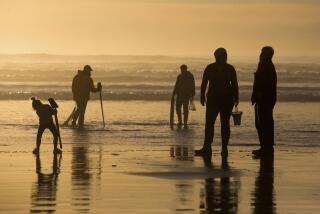Fishing Boats to Be Watched ‘Down to the Last Crab’
- Share via
ANCHORAGE — In the midst of a spreading oil spill from a wrecked freighter, hundreds of crab fishermen ventured into the Bering Sea this weekend, undaunted by concerns that their catches could be contaminated.
About 200 crab-fishing boats dropped their pots into the frigid waters off the Aleutian Islands despite reports in recent days that oil globs as big as two feet in diameter had reached Dutch Harbor, home port for the region’s crab fleet. Dutch Harbor is about 50 miles from the site of the freighter Selendang Ayu, which is believed to have spilled as much as 200,000 gallons of fuel oil.
State and fishery officials said the crab harvest, expected to last about three weeks, would be monitored like never before -- “down to the last crab,” as one official said -- to ensure that no contaminated seafood reached the marketplace.
“The level of scrutiny will be unprecedented,” said Laura Fleming of the Alaska Seafood Marketing Institute, a government agency that represents the state’s seafood industry.
Fleming said state and fishery officials would be on boats, in processing plants and “at every level of the process” to test for oil residue.
The fishermen must travel within pre-determined “corridors” -- far from known contaminated areas -- to get to their fishing grounds several hundred miles north of Dutch Harbor.
“All it takes is one bad incident to hurt the whole fishery,” Fleming said.
But, she said, people worried about contamination must try to understand the vastness of area. The fishing and crabbing grounds stretch across an area 600 miles by 850 miles. But, she said, the oil spill would affect only a minuscule fraction of the fishing grounds.
The main catch will be the spindly-legged opilio, known in the Lower 48 as snow crab. This year’s quota is nearly 20 million pounds, which is expected to fetch about $35 million for the fishermen.
Working parallel with the crab fishermen in the Bering Sea are dozens of state workers and volunteers trying to contain what appears to be a growing oil spill.
The Selendang Ayu, a 738-foot Malaysian freighter, was carrying soybeans when it ran aground in Skan Bay off Unalaska Island on Dec. 8. Unalaska is east of the halfway point on the Aleutian chain. The freighter, bashed by heavy seas, broke in half, slowly spilling fuel oil.
It’s unknown how much of the estimated 442,000 gallons of fuel once on the boat remains on the ship.
Workers have struggled amid rough seas to board the ship with equipment to pump out what is left. The forward section of the vessel is submerged. Workers have tried to erect barriers on the ship’s deck to protect them from crashing waves, but the strategy has been only partially successful.
On nearby shorelines, workers have filled 13,700 large plastic bags with oil waste, amounting to about 228 cubic yards of viscous debris, said Vivian Kinnaird of the state Department of Environmental Conservation.
Crews also have found a handful of dead otters and 645 dead birds -- including ducks, geese, seagulls, sandpipers, crested auklets and cormorants. Nearly 30 oiled birds have been rescued.
In an indication of how far the spill has spread, oil globs were discovered last week near Dutch Harbor.
The tar balls ranged in diameter from a few inches to a couple of feet. They were slick, dark brown and goopy. Such globs can drift hundreds of miles, prompting new concerns about the continuing effects of the spill.
The true scope of the damage might not be known for months or years, said Petty Officer Thomas McKenzie, spokesman for the U.S. Coast Guard in Dutch Harbor. McKenzie said that even with a sizable cleanup force -- 16 vessels, eight aircraft and dozens of workers -- their efforts were limited by light and weather.
At this time of year, there are 6 1/2 hours of sunlight each day; and once crews are on the water, McKenzie said, they must endure sub-freezing temperatures, 40-knot winds and 6-foot swells. And that doesn’t include storms, which are routine in winter.
State and federal officials are mapping out a strategy for the spring and summer, as the cleanup effort is expected to last at least that long. It may be early summer, McKenzie said, when the days lengthen and the seas calm, before scientists can determine how far the oil has reached.
More to Read
Sign up for Essential California
The most important California stories and recommendations in your inbox every morning.
You may occasionally receive promotional content from the Los Angeles Times.












